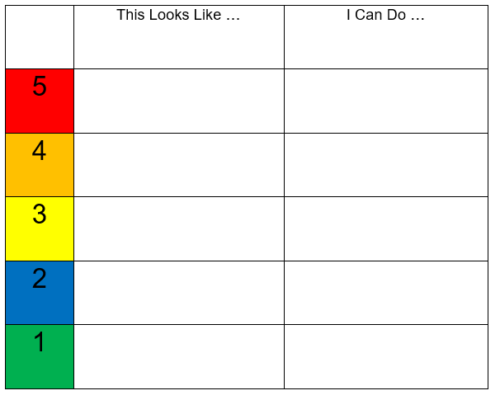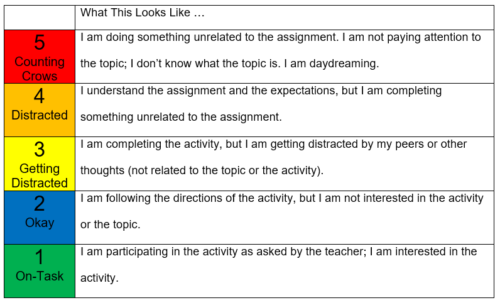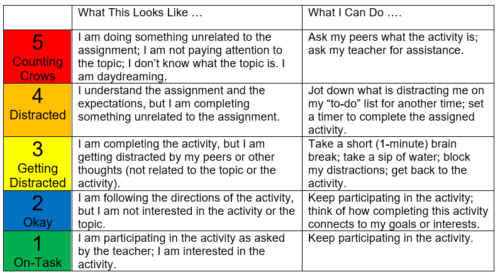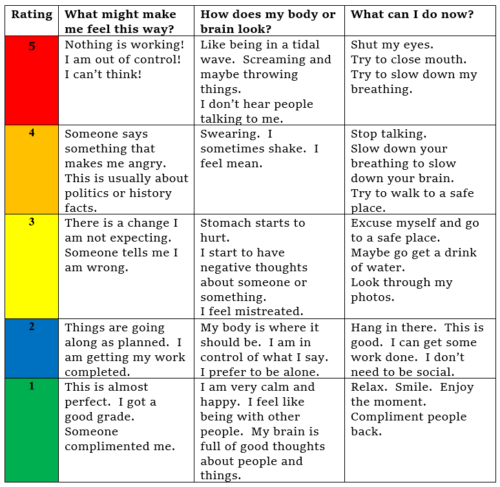By LaShauna Britt, M.Ed., Daria Lorio-Barsten, M.Ed, BCBA, and Kara McCulloch, M.S.
Happy New Year! Now is that time of the school year when teachers start to rethink their classroom behavior management systems. We wonder, “How effective is our current classroom management system and does it address the needs of all of our students?” We might also ask ourselves, “Have I provided visual supports within my behavior system?” These questions are helpful to consider before assessing or implementing your need for visual supports within your class.]
What are visual supports? Visual supports are an effective behavioral strategy that includes providing concrete items, pictures, symbols, printed words, or a combination of these. These types of supports may assist children with maintaining attention, understanding spoken language, and sequencing and organizing their environment (Hodgdon, 1995). In the classroom, visual supports help students understand directions, schedules, rules, and instructional materials (Jaime & Knowlton, 2007). The effectiveness of providing visual supports for students with autism within the classroom has strong research support; however, visual supports can help all students and assist teachers with defining their classroom behavioral expectations.
How can you incorporate visual supports into your current behavior management system, or how can you create an effective classroom behavior management system using visual supports? One tool to help you assess your classroom use of visual supports is a visual supports checklist. A visual supports checklist prompts you to ask yourself some of the following questions:
- Do my students understand where to find things and where they belong?
- Do they understand when things will happen (e.g., class schedules or agendas)?
- Do they understand the curriculum, classroom, and community expectations (i.e., rules)?
- Do they have the social skills necessary to interact successfully in their school environment and communities?
- Do they know how to effectively communicate with their peers and teachers?
Using a checklist will help you determine where to begin creating an environment that effectively uses visual supports, or how to update your current classroom visual supports. Visit the website supported by the University of Maine to view a Visual Supports Checklist by Bennett-Armistead, Blagojevic, Neal, and Taylor (2016).
The Incredible 5-Point Scale (see Figure 1), designed by Buron and Curtis (2003), is an example of a versatile visual support that can be used in classrooms to teach a variety of behaviors.
Figure 1. The Incredible 5-Point Scale.

(Adapted from Buron & Curtis, 2003. Used with permission.)
The scale is based on three strategies: Simon Baron-Cohen’s educational theory of hyper-systemizing (according to which some individuals learn better within systems such as charts, graphs, numbers, and scales), cognitive behavioral therapy (teaching self-awareness and social awareness rather than external management of behavior), and visual supports (K. Buron, personal communication, January 5, 2018).
This simple and practical scale breaks down any challenging situation or behavior, and helps organize the student’s thinking process on how to manage it. The scale consists of five rows and one or more columns. The first column lists numerals 1-5 each coded in a different color to demonstrate levels of intensity of a given behavior. Other columns can be designed based on the needs of a student and the planned use for the scale. Adding what a behavior looks like or feels like as the second column helps students identify the particular behavior. Finally, including a column “what to do” can help students find and record strategies to de-escalate and self-manage the target behavior/issue. Self-monitoring strategies have been shown to be effective positive behavioral interventions for both general and special education students (Sheffield & Waller, 2010).
Developing the Incredible 5-Point Scale
The first step in using The Incredible 5-point Scale is to identify a challenging behavior together with the student. For example, does the student struggle with staying on task or get anxious or upset? It is important to develop the scale with the student, using the student’s own words as much as possible.
The next step is to break down the behavior into five parts, clearly illustrating the degrees of the situation and organizing the information into a visual scale (Buron & Curtis, 2003). Teachers should avoid using arbitrary judgments (i.e., avoid words such as “appropriate,” “inappropriate,” “good,” or “bad” (K. Buron, personal communication, January 5, 2018). Instead, descriptions should be used to define what each step looks or feels like. An example of a breakdown of on-task behavior appears in Figure 2.
Figure 2. 5-Point Scale for On-Task Behavior.

Next, together with the student, identify some behaviors to reduce the current level of the behavior/situation. What can a student do during that state to get to a level 1 or 2 on the scale? Suggestions should include only the behaviors that have student buy-in. An example might look similar to the one below in Figure 3 (based on student input).
Figure 3. 5-Point Scale for Behaving On-Task Using Strategies.

The scale can include other columns based on student needs such as “How This Is Impacting Others” or “Outcome of Engaging in This Level.”
Implementing the 5-Point Scale
For any visual support, it is critical to first teach the appropriate use of the tool, practice it with feedback, and recognize the students for using it successfully. Combining the visual support of a 5-point scale with the self-monitoring intervention can improve behavior management in the classroom and preserve instructional time.
Once the scale has been developed, initially use it in a direct instructional setting by prompting the student to identify where on the scale he or she is during specific situations and what to do to move to a lower level on the scale. You can teach this through developing and role-playing scenarios that frequently result in the challenging behavior and then prompting the student to identify what to do in those instances. Then move toward applying the scale to real situations that the student experiences. The scale can be used (a) for pre-teaching before a challenge arises, (b) during the challenge to provide visual supports and directions on how to manage the situation, or (c) as a tool for reflection after an event has occurred. As students use the scale over time, remember to fade the prompts and build independent use. Periodically check in with the students to ensure that they are using the scale accurately.
The Incredible 5-Point Scale can also be used as a support for managing stress and anxiety or for identifying and dealing with other emotions. Kari Buron, the developer of The Incredible 5-Point scale, provides many downloadable examples of what the scale may look like for a variety of behaviors. Visit The Incredible 5-Point Scale website to find more examples.
Figure 4 illustrates one of Buron’s examples for self-management.
Figure 4. 5-Point Scale for Self-Management.

(Kari Dunn Buron, 2010, https://www.5pointscale.com/more_sweet_scale.htm/. Used with permission.)
In addition to use with individual students, the scale can also be implemented with a whole class for situations such as managing the noise level during small groups (see Figure 5). Using a visual support to redirect students to a more appropriate noise level is faster and more efficient than repeated verbal reminders. Throughout, it is important to remember that the scale is designed to be a teaching tool, not a consequence system. That is, the focus is on teaching how to manage challenging situations, not punishing students for making mistakes. Posting the number for the desired noise level in each setting or during each activity can be helpful for both students and teachers.
Figure 5. 5-Point Scale for Volume Control.

Visual supports play an important role in almost every aspect of our adult lives. We rely on them for cues to tell us what to do, where to go, when to move, and how to behave. They are of equal importance in the classroom and can assist students as they acquire and master academic and behavioral skills. The Incredible 5-Point scale is an example of a visual support that can be adapted in numerous ways to help students build self-regulation skills and gain independence. It is just one visual support tool that can help you as you continue to foster student success within your classroom.
References
Buron, K. D., & Curtis, M. (2003). The incredible 5-point scale: Assisting students with autism spectrum disorders in understanding social interactions and controlling their emotions responses. Shawnee Mission, KS: Autism Asperger Publishing Company.
Hodgdon, L. (1995). Visual strategies for improving communication practical supports for school and home. Troy, MI: QuirkRoberts Publishing.
Jaime, K., & Knowlton, E. (2007). Visual supports for students with behavior and cognitive challenges. Intervention in School and Clinic, 42(5), 259-270.
Sheffield, K., & Waller, R. J. (2010). A review of single-case studies utilizing self-monitoring interventions to reduce problem classroom behaviors. Beyond Behavior, 19(2), 7-13.




